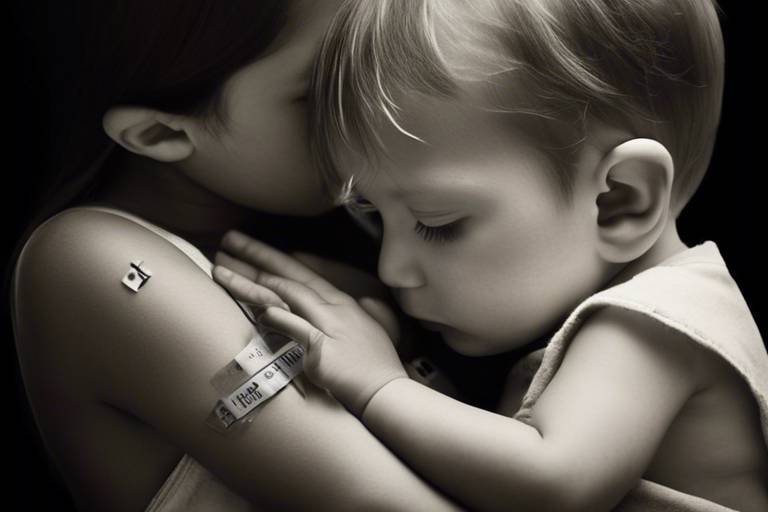Introducing Mental Health to Kids: Age Appropriate Conversations
Talking about mental health with children might seem like a daunting task, but it’s absolutely essential for fostering their emotional well-being. Just like we teach them about physical health—like washing hands and eating veggies—we must also equip them with the tools to understand their feelings and emotions. Imagine mental health as a garden; if we nurture it from a young age, it will flourish beautifully, allowing our children to grow into resilient adults. But how do we start this conversation? What language should we use? And when is the right time to introduce these concepts? In this article, we’ll explore age-appropriate strategies that make discussing mental health not only effective but also engaging for kids.
Before diving into conversations with children, it’s crucial for parents and educators to understand the fundamental concepts of mental health. Mental health encompasses our emotional, psychological, and social well-being, influencing how we think, feel, and act. It also plays a vital role in how we handle stress, relate to others, and make choices. Here are some key terms and ideas that can be shared with children:
- Feelings: The emotions we experience, like happiness, sadness, anger, and fear.
- Emotional well-being: How we feel about ourselves and our ability to cope with life's challenges.
- Resilience: The ability to bounce back from difficult situations.
By using simple definitions and relatable examples, we can help children grasp these concepts and understand that everyone has feelings, and it's okay to talk about them.
When discussing mental health with kids, the language we use is incredibly important. Children’s cognitive abilities vary greatly with age, so it’s essential to tailor our conversations accordingly. For example, using complex terminology can confuse younger kids, while teens may benefit from a more nuanced discussion. The goal is to make these conversations accessible and relatable. Think of it like telling a story; you wouldn't use Shakespearean language to explain a fairy tale to a toddler!
For preschoolers, the focus should be on simple concepts and engaging activities that promote emotional awareness. At this age, children are just beginning to understand their feelings, so it’s essential to introduce them to the vocabulary of emotions. Here are some effective techniques:
Stories and play are fantastic tools for discussing mental health with young children. Picture this: you’re reading a story about a little bear who feels sad because he lost his favorite toy. As you read, you can pause and ask, “How do you think the bear feels?” This not only makes the conversation enjoyable but also encourages kids to express their own feelings in a safe space.
Another important aspect is helping preschoolers identify and express their emotions. You can create an “emotion chart” with faces showing different feelings—happy, sad, angry, surprised—and encourage children to point to how they feel. This simple activity lays the groundwork for emotional intelligence and resilience, teaching them that it’s okay to feel a wide range of emotions.
As children enter school, their understanding of emotions becomes more sophisticated. This is a great time to emphasize the significance of open dialogue about mental health. Encourage them to share their feelings by asking questions like, “What made you feel happy today?” or “Did anything upset you?” This not only fosters emotional literacy but also strengthens the parent-child relationship.
When it comes to teenagers, discussing mental health can be a bit trickier. They are navigating a whirlwind of emotions, peer pressures, and identity issues. It’s crucial to create a safe space for sharing, where they feel validated and heard. Active listening is key here—sometimes, just letting them talk without interruption can make all the difference.
Stigma surrounding mental health can prevent teens from speaking openly about their struggles. It’s vital to have conversations that normalize mental health discussions. Remind them that seeking help is a sign of strength, not weakness. You could say, “Just like we go to the doctor for a physical ailment, it’s okay to seek help for our mental health too.”
Finally, equip both parents and teenagers with resources that promote mental health awareness and support. This can include:
- Books on emotional intelligence for kids and teens.
- Websites dedicated to mental health education.
- Community programs and workshops focused on emotional well-being.
These resources can help reinforce the conversation and provide additional support when needed.
Q: At what age should I start talking to my child about mental health?
A: It's never too early! Start with simple concepts about feelings as soon as they can express emotions.
Q: How can I make these conversations less intimidating?
A: Use stories and play to introduce topics. Make it fun and relatable, so children feel comfortable sharing their feelings.
Q: What if my teenager doesn't want to talk about their feelings?
A: Respect their space but let them know you’re there to listen whenever they’re ready. Sometimes, just being present is enough.

Understanding Mental Health Basics
Mental health is a term that often gets thrown around, but what does it really mean? At its core, mental health refers to our emotional, psychological, and social well-being. It affects how we think, feel, and act. Just like we take care of our physical health by eating well and exercising, it’s equally important to nurture our mental health. This is especially true for children, who are still developing their understanding of emotions and relationships.
When we talk about mental health, we’re diving into a pool of concepts that can feel overwhelming. To make it easier for parents and educators, let’s break down some fundamental ideas:
- Emotions: These are feelings we experience in response to different situations. Understanding emotions helps children articulate what they’re feeling.
- Resilience: This is the ability to bounce back from challenges. Teaching kids how to cope with stress and setbacks is crucial.
- Self-esteem: This refers to how we value ourselves. Building a positive self-image is essential for mental well-being.
As children grow, their understanding of these concepts evolves. For instance, a preschooler might feel sad when a toy breaks, while a teenager might grapple with feelings of inadequacy during a tough academic year. Recognizing these differences is key to having age-appropriate conversations about mental health.
Moreover, mental health is not just the absence of mental illness. It encompasses a range of emotional states, including happiness, sadness, anxiety, and stress. Just like a garden needs water, sunlight, and care to thrive, our mental health requires attention and nurturing. This is where parents and educators play a vital role in fostering an environment where children feel safe to express their feelings and seek help when needed.
Understanding mental health basics also involves recognizing the signs of emotional distress. Children may exhibit changes in behavior, such as withdrawal from activities they once enjoyed, changes in sleep patterns, or difficulty concentrating. Being aware of these signs can help adults intervene early and provide the necessary support.
In conclusion, grasping the fundamentals of mental health is the first step in guiding children through their emotional journeys. By equipping ourselves with knowledge, we can foster an environment that promotes open discussions about feelings and encourages kids to seek help when they need it. This not only benefits their mental health but also enriches their overall development.

Age-Appropriate Language
When it comes to discussing mental health with children, using is crucial. Just like you wouldn’t use complex jargon to explain a math problem to a 5-year-old, the same principle applies to conversations about feelings and emotions. The words we choose can either open doors to understanding or shut them tight, leaving kids feeling confused and isolated. So, how do we bridge this gap? It’s all about tailoring our vocabulary and examples to fit their developmental stage.
For younger children, particularly those in preschool, simple and relatable terms are the way to go. Instead of saying “anxiety,” you might describe it as feeling “worry” or “nervous.” You can say something like, “It’s okay to feel nervous when you’re trying something new, like going to a new school.” This not only makes the concept more digestible but also normalizes the feelings they might experience. Using analogies can be incredibly effective; for instance, comparing emotions to weather can help children visualize what they’re feeling. You might say, “Sometimes I feel like a sunny day, and other times I might feel like it’s raining inside.”
As children grow into the school-aged group, their cognitive abilities expand, and so can the complexity of the language we use. At this stage, it’s essential to introduce terms like “stress” and “emotional health” while ensuring that you explain what they mean. Engaging them in conversations about their daily experiences can help. Ask questions like, “What makes you feel happy or sad?” This not only encourages them to articulate their feelings but also allows you to gently introduce the vocabulary associated with mental health.
For teenagers, the language shifts again. They are at a stage where they crave deeper understanding and validation of their feelings. Using phrases that resonate with their experiences, such as “mental health is just as important as physical health,” can be a game-changer. It’s vital to create a safe space where they feel comfortable exploring these topics without fear of judgment. Encourage open dialogue by asking, “Have you ever felt overwhelmed? What did that feel like for you?” This approach fosters trust and encourages them to express themselves freely.
In summary, the key to effective communication about mental health lies in understanding your audience. By using language that resonates with their age and emotional maturity, you pave the way for meaningful discussions. Remember, it’s not just about talking; it’s about connecting. And when you connect, you build a foundation of understanding that can last a lifetime.
- Why is age-appropriate language important when discussing mental health?
Using age-appropriate language helps children understand complex feelings and concepts, making it easier for them to express themselves. - How can I tell if my child understands what I'm saying?
Engage them in conversation and ask open-ended questions to gauge their understanding and encourage them to share their thoughts. - What if my child is reluctant to talk about their feelings?
Try using stories or relatable scenarios to initiate the conversation. Sometimes, a comfortable context can help them open up.

Preschool Age Conversations
When it comes to discussing mental health with preschoolers, the key is to keep it simple and engaging. At this age, children are just beginning to understand their own feelings and those of others, making it the perfect time to introduce concepts of emotional awareness. You might wonder, how can we make these conversations both fun and meaningful? One effective approach is through the use of stories and play. Children naturally gravitate towards stories, and by incorporating narratives that highlight different emotions, you can create a safe space for them to express themselves.
For example, consider reading a story about a character who feels sad after losing a toy. As you read, pause to ask questions like, “How do you think the character feels?” or “What do you think they could do to feel better?” This not only encourages empathy but also helps children articulate their own feelings. By making the conversation interactive, you’re helping them connect the dots between the story and their own experiences.
Another vital aspect of these conversations is identifying emotions. Preschoolers often struggle to name their feelings, which can lead to frustration. To assist them, you can use emotion cards or a feelings chart. These tools visually represent different emotions, allowing children to point out how they feel. You might say, “Look at these cards! Can you show me how you feel today?” This simple activity empowers them to communicate their emotions, laying the groundwork for emotional intelligence.
Furthermore, engaging in activities like art can also facilitate discussions about feelings. Encourage children to draw a picture that represents how they feel or to create a “feelings collage” using magazine cutouts. This hands-on approach not only makes the conversation enjoyable but also helps them express complex emotions in a tangible way. Remember, the goal is to normalize discussions about feelings and mental health, making it as natural as talking about the weather.
Lastly, it’s essential to reassure preschoolers that it’s okay to feel a range of emotions. You might say something like, “Sometimes we all feel happy, and sometimes we feel sad, and that’s perfectly normal!” This validation helps them understand that emotions are a natural part of life. By instilling this understanding early on, you’re equipping them with the tools they need to navigate their emotions as they grow.
- What age is appropriate to start discussing mental health with children? It's beneficial to start these conversations as early as preschool age, using simple language and relatable concepts.
- How can I tell if my child is struggling with their emotions? Look for signs like changes in behavior, withdrawal from activities, or difficulty expressing feelings. Open dialogue is crucial.
- Are there specific books for preschoolers about emotions? Yes, there are many wonderful children's books that explore feelings and can serve as great conversation starters.

Using Stories and Play
When it comes to introducing mental health concepts to preschoolers, stories and play can be your best allies. Children have vibrant imaginations and a natural inclination for storytelling, which makes these methods not only effective but also enjoyable. Imagine a world where a little bear feels sad because he lost his favorite toy. Through this narrative, children can learn about feelings in a relatable way. They can see that it’s okay to feel sad sometimes and that talking about it can help. This is the magic of storytelling—it creates a safe space for children to explore their emotions.
Using characters that children can connect with allows them to project their feelings onto these figures. For instance, if a character in a story experiences anxiety about starting school, it opens the door for children to express their own fears. You can follow up the story with questions like, “How do you think the bear felt?” or “Have you ever felt that way?” These questions encourage children to reflect on their own emotions and share their experiences.
Play, on the other hand, provides a hands-on approach to understanding mental health. Activities such as role-playing can help children act out different emotional scenarios. For instance, using puppets to demonstrate a conflict between two friends can lead to discussions about feelings like anger, jealousy, or sadness. This interactive engagement not only makes learning fun but also allows children to practice empathy and problem-solving skills in a safe environment.
Incorporating art into play can also be a powerful tool. Ask children to draw their feelings or create a collage that represents happiness, sadness, or any emotion they want to express. This not only gives them a creative outlet but also helps them articulate what they might not have the words for yet. You can even set up a “feelings corner” in your home or classroom where children can go to express themselves through art, stories, or simply by talking.
Ultimately, the goal is to make conversations about mental health feel natural and accessible. By weaving these discussions into stories and play, you’re not just teaching children about emotions; you’re equipping them with the tools they need to navigate their feelings as they grow. Remember, the earlier we start these conversations, the more prepared they will be to handle life's emotional ups and downs.

Identifying Emotions
Identifying emotions in preschoolers is akin to teaching them to navigate a colorful maze of feelings. At this tender age, children are just beginning to understand the vast spectrum of emotions they experience daily. It's crucial for parents and caregivers to help them label these feelings accurately. Why is this important? Because when kids can recognize and name their emotions, they are better equipped to express themselves, leading to healthier emotional development.
One effective method to help preschoolers identify their emotions is through the use of emotion charts. These charts can be filled with vibrant images representing various feelings, such as happiness, sadness, anger, and surprise. By having these visuals readily available, children can point to the image that best describes how they feel at any given moment. This simple act of pointing can serve as a bridge to deeper conversations about their emotions, making it easier for them to articulate their feelings. Here's a sample of what an emotion chart might look like:
| Emotion | Image Example |
|---|---|
| Happy |  |
| Sad |  |
| Angry |  |
| Surprised |  |
In addition to using emotion charts, engaging in interactive activities can significantly enhance a child's ability to identify their emotions. For instance, playing games that involve role-playing different scenarios allows children to express how they would feel in various situations. You might ask, "How do you think this character feels when they lose their favorite toy?" Such questions encourage children to think critically about emotions and develop empathy towards others.
Moreover, incorporating stories into your discussions about feelings can be tremendously beneficial. As you read a story together, pause and ask your child how they think the characters are feeling at different points in the narrative. This not only helps them identify emotions but also fosters a deeper understanding of how feelings can change over time. Engaging with stories is like opening a window to the world of emotions, allowing children to see reflections of their own experiences.
Ultimately, the goal of helping preschoolers identify their emotions is to lay a solid foundation for emotional intelligence. By teaching them to recognize and express their feelings, we empower them to communicate effectively and build strong relationships with others. Remember, every conversation about emotions is a step towards creating a more emotionally aware generation.
- Why is it important for preschoolers to identify their emotions? Identifying emotions helps children express themselves, leading to better emotional regulation and healthier relationships.
- How can I encourage my child to talk about their feelings? Use open-ended questions, engage in role-playing, and provide tools like emotion charts to facilitate discussions.
- What activities can help preschoolers understand emotions? Storytelling, role-playing, and interactive games are effective ways to help children explore and express their feelings.

School-Aged Children Discussions
When it comes to discussing mental health with school-aged children, the approach becomes a bit more intricate, yet incredibly rewarding. At this stage, children are developing their critical thinking skills and can grasp more complex ideas. This is the perfect time to introduce the concept of mental health as a vital part of overall well-being. Think of it like teaching them about nutrition; just as we need to eat healthy foods for our bodies, we also need to take care of our minds. By framing mental health in a relatable way, parents and educators can foster an environment where children feel safe to express their feelings.
One effective strategy is to create an open dialogue about emotions and mental health. Ask engaging questions that encourage children to share their thoughts. For example, you might say, "Have you ever felt really sad or anxious about something? What did that feel like?" This not only validates their feelings but also shows them that it's okay to talk about emotions. It's essential to listen actively, nodding along and making eye contact, so they know you're genuinely interested in what they have to say.
Another key aspect of these discussions is the importance of emotional literacy. Helping children identify and label their feelings can empower them to express themselves more effectively. You might introduce a simple feelings chart that includes various emotions such as happy, sad, angry, and scared. Encourage them to point to how they feel on the chart. This visual aid serves as a bridge to deeper conversations about what those feelings mean and how to cope with them. Remember, the goal is to normalize these discussions, making mental health as commonplace as talking about a cold or a scraped knee.
In addition to conversations, incorporating stories and media can be an excellent way to introduce mental health topics. You can read books or watch age-appropriate shows that feature characters dealing with emotions. Afterward, discuss the characters' feelings and choices. This not only makes the conversation more relatable but also allows children to see that they are not alone in their experiences. It’s like holding a mirror to their own lives, reflecting back the complexities of human emotions.
Lastly, don’t forget to model healthy emotional practices yourself. Children learn a lot from observing adults. When they see you managing stress, expressing your feelings, and seeking help when needed, they’re more likely to adopt those behaviors themselves. Remember, the goal is to create a safe space where school-aged children feel comfortable discussing their mental health without fear of judgment or misunderstanding.
- How can I tell if my child is struggling with mental health issues? Look for changes in behavior, mood swings, withdrawal from activities, or changes in academic performance. Open communication is key.
- What should I do if my child doesn’t want to talk about their feelings? Respect their space but gently encourage them by sharing your own feelings. Sometimes, sharing your experiences can help them feel more comfortable opening up.
- Are there resources available for parents to learn more about child mental health? Absolutely! Numerous books, online courses, and community workshops focus on mental health education for parents and children.

Teenagers and Mental Health
When it comes to teenagers, discussing mental health can feel like navigating a minefield. The teenage years are often tumultuous, filled with **emotional highs and lows** that can be overwhelming. It's essential to recognize that mental health is just as important as physical health, yet many teens might feel hesitant to talk about their feelings. So, how can we create an environment where they feel safe to express themselves? The answer lies in **validation**, **active listening**, and fostering a sense of security.
First off, let’s talk about **validation**. Teens want to feel heard and understood. When they share their feelings, it’s crucial to acknowledge their experiences without jumping to conclusions or offering unsolicited advice. For instance, if a teenager expresses anxiety about school, instead of saying, “You shouldn’t worry about it,” try responding with, “It’s completely normal to feel anxious sometimes. Want to talk about what’s bothering you?” This simple shift can make a world of difference, showing them that their feelings are valid.
Next, active listening is key. This means giving them your full attention, making eye contact, and showing genuine interest in what they have to say. It’s not just about hearing the words; it’s about understanding the emotions behind those words. You might find that a simple nod or a thoughtful question can encourage them to open up even more. Remember, it’s okay to sit in silence for a moment; sometimes, they just need time to gather their thoughts.
Creating a **safe space** for sharing is another vital aspect. This involves making sure that your teenager knows they can talk to you without fear of judgment or punishment. Establishing trust is essential, and it can be built through consistent, open communication. Encourage your teen to express themselves freely and reassure them that it’s perfectly okay to seek help. You might even want to share your own experiences—showing vulnerability can help them feel less alone.
However, it’s also important to address the **stigma** surrounding mental health. Many teenagers might feel embarrassed or ashamed to discuss their struggles, fearing they will be labeled or misunderstood. As a parent or guardian, you can help combat this stigma by promoting mental health awareness. Talk about it openly, share resources, and encourage them to seek help from professionals when needed. Here are some effective strategies:
- Discuss mental health as openly as physical health.
- Provide them with literature or resources about mental health.
- Encourage them to participate in school or community programs focused on mental well-being.
Lastly, let's not forget about the **resources** available for both teens and parents. There are numerous books, websites, and community programs dedicated to promoting mental health awareness. For instance, websites like TeenMentalHealth.org and Mind.org.uk offer valuable information and tools for understanding mental health issues. Additionally, local community centers often provide workshops and support groups that can be incredibly beneficial.
In conclusion, discussing mental health with teenagers doesn't have to be daunting. By practicing validation, active listening, and creating a safe environment, we can empower them to share their feelings and seek help when needed. Remember, the goal is to foster an open dialogue about mental health, ensuring that our teens know they are not alone in their struggles.
Q: How can I tell if my teenager is struggling with their mental health?
A: Look for changes in behavior, mood swings, withdrawal from activities, or changes in sleep and appetite. If you notice significant shifts, it might be time to have a conversation.
Q: What should I do if my teenager refuses to talk about their feelings?
A: Respect their space but let them know you’re available whenever they feel ready to talk. Sometimes, just knowing you're there can be comforting.
Q: Are there specific signs of mental health issues in teenagers?
A: Yes, signs can include persistent sadness, anger, irritability, changes in academic performance, and loss of interest in activities they once enjoyed.
Q: How can I encourage my teenager to seek professional help?
A: Normalize the idea of seeking help by discussing it openly. You can also offer to accompany them to appointments or help them find a therapist they feel comfortable with.

Addressing Stigma
When it comes to discussing mental health with teenagers, one of the most significant barriers we face is the pervasive stigma surrounding mental health issues. This stigma can create a wall between those who need help and the support systems available to them. It's crucial for parents, educators, and peers to understand that mental health is just as important as physical health. Imagine if someone broke their leg but felt too embarrassed to seek medical attention; this is similar to how many teenagers feel when it comes to their mental health. By addressing this stigma head-on, we can create a more open and supportive environment for our youth.
To effectively tackle stigma, we must first acknowledge its existence and the impact it has on young people. Stigma can manifest in various ways, such as negative stereotypes, discrimination, and a lack of understanding. Many teenagers might feel that admitting to mental health struggles will lead to judgment or exclusion from their peers. This fear can prevent them from seeking help, which is why it's vital to foster a culture of acceptance and understanding. A supportive conversation can make all the difference. Ask your teen how they feel and listen without judgment. This simple act can help dismantle the barriers that stigma creates.
Furthermore, it's essential to educate both teenagers and adults about mental health. Awareness is key! Here are some effective strategies to help address stigma:
- Open Dialogue: Encourage open conversations about mental health at home and in schools. When teenagers see their parents or teachers discussing these topics, they are more likely to feel comfortable sharing their own feelings.
- Normalize Mental Health Discussions: Make mental health a regular topic of conversation. Just like we talk about physical health, we should discuss mental well-being openly and without shame.
- Share Personal Stories: When appropriate, share personal experiences related to mental health. Hearing about others' struggles can help teens feel less alone and more understood.
- Promote Educational Resources: Provide access to books, websites, and workshops that focus on mental health education. Knowledge is a powerful tool in dispelling myths and misconceptions.
By implementing these strategies, we can help create a more accepting environment for our teenagers. Remember, the goal is to make mental health discussions as commonplace as talking about sports or school. Encourage your teen to express their feelings and validate their experiences. Let them know that seeking help is a sign of strength, not weakness.
In conclusion, addressing stigma is a critical step in supporting teenagers' mental health. By fostering open conversations, educating ourselves and others, and normalizing mental health discussions, we can help dismantle the barriers that prevent teens from seeking help. Together, we can create a culture where mental health is prioritized and everyone feels safe to share their experiences.
Q: How can I tell if my teenager is struggling with mental health issues?
A: Look for signs such as changes in mood, withdrawal from activities, changes in sleep or appetite, and difficulty concentrating. Open communication is key; ask them how they are feeling.
Q: What should I do if my teenager refuses to talk about their feelings?
A: Be patient and let them know you are there for them when they are ready to talk. Encourage them to express themselves in other ways, such as through art or journaling.
Q: Are there any resources for teenagers struggling with mental health?
A: Yes! Many schools offer counseling services, and there are numerous hotlines and online resources available. Educate yourself and your teen about these options.
Q: How can I support my teenager if they are diagnosed with a mental health condition?
A: Listen without judgment, educate yourself about their condition, and encourage them to seek professional help. Be a source of support and understanding.

Resources for Support
When it comes to mental health, having the right resources at your fingertips can make all the difference. For both parents and teenagers, understanding where to turn for help is crucial. There are numerous avenues available that can provide support, guidance, and education regarding mental health issues. It’s like having a toolbox filled with various tools to tackle different challenges. Each resource plays a unique role in fostering mental well-being.
For parents, starting with books can be incredibly beneficial. There are many titles specifically aimed at helping adults understand and discuss mental health with children. For instance, books like The Whole-Brain Child by Daniel J. Siegel and Tina Payne Bryson offer insights into child development and emotional regulation. Additionally, How to Talk So Kids Will Listen & Listen So Kids Will Talk by Adele Faber and Elaine Mazlish provides practical communication strategies that can be applied to mental health discussions.
Online resources also play a significant role. Websites such as NAMI (National Alliance on Mental Illness) offer a wealth of information for both parents and teens. They provide educational materials, support groups, and hotlines that can be invaluable in times of need. The MentalHealth.gov site is another excellent resource, offering guidance on how to recognize mental health issues and where to seek help.
For teenagers, it’s essential to have access to peer support. Organizations like Befrienders Worldwide provide a platform for teens to connect with others who may be experiencing similar challenges. This sense of community can be incredibly comforting, reminding them that they are not alone in their struggles.
Furthermore, many schools have counselors who can provide immediate support and guidance. Encouraging teens to speak with their school counselor can bridge the gap between feeling overwhelmed and finding solutions. It’s vital for them to understand that seeking help is a sign of strength, not weakness.
Lastly, community programs often offer workshops and seminars focused on mental health awareness. These events not only educate but also create a supportive environment where families can learn together. By participating in such activities, both parents and children can develop a deeper understanding of mental health and the importance of emotional well-being.
In summary, having a variety of resources at your disposal can empower families to address mental health issues effectively. Whether it’s through books, websites, peer support, or community programs, the key is to foster open conversations and seek help when needed. Remember, just like any other aspect of health, mental health deserves attention and care.
- What are some signs that my child may need mental health support?
Look for changes in behavior, such as withdrawal from activities, changes in sleep patterns, or sudden mood swings. If you notice persistent sadness or anxiety, it may be time to seek help.
- How can I start a conversation about mental health with my child?
Begin by creating a safe and open environment. Use age-appropriate language, share your own feelings, and encourage your child to express theirs. Simple questions like “How was your day?” can open the door to deeper discussions.
- Are there specific books for teenagers on mental health?
Yes! Books like Reasons to Stay Alive by Matt Haig and It's Kind of a Funny Story by Ned Vizzini can resonate well with teens, providing relatable content about mental health struggles.
Frequently Asked Questions
- What is mental health, and why is it important for kids?
Mental health refers to our emotional, psychological, and social well-being. It's important for kids because it affects how they think, feel, and behave. Just like physical health, good mental health helps children cope with the stresses of life, build relationships, and make choices. Teaching kids about mental health early on can foster resilience and emotional intelligence.
- At what age should I start talking to my child about mental health?
You can start discussing mental health concepts as early as preschool age. Simple conversations about feelings, emotions, and coping strategies can lay a strong foundation. As they grow older, you can introduce more complex ideas and encourage open dialogue about their thoughts and feelings.
- How can I make discussions about mental health less intimidating for my child?
Using stories, play, and relatable examples can make these conversations more engaging and less daunting. For younger kids, consider using puppets or toys to express emotions. For older children, sharing personal experiences or using popular media can help them relate to the topic.
- What are some signs that my child may be struggling with their mental health?
Signs can vary, but common indicators include changes in mood, withdrawal from friends and activities, changes in appetite or sleep patterns, and difficulty concentrating. If you notice persistent changes in behavior or emotional state, it may be time to have a more in-depth conversation or seek professional help.
- How can I encourage my teenager to talk about their mental health?
Creating a safe, non-judgmental space is key. Let your teenager know that it's okay to express their feelings and that you're there to listen. Validate their emotions, be patient, and engage in active listening. Sometimes, simply being present can encourage them to open up.
- What resources are available for parents to learn more about mental health?
There are numerous resources available, including books, websites, and community programs. Websites like the National Alliance on Mental Illness (NAMI) and Mental Health America offer valuable information. Additionally, consider checking local libraries for books aimed at parents and children discussing mental health.
- How can I help reduce the stigma around mental health in my child's life?
Start by having open conversations about mental health in your home. Normalize discussions around feelings and emotions. Encourage empathy and understanding towards others who may be struggling. Teaching your child to speak openly about mental health can help break down barriers and foster a supportive environment.



















